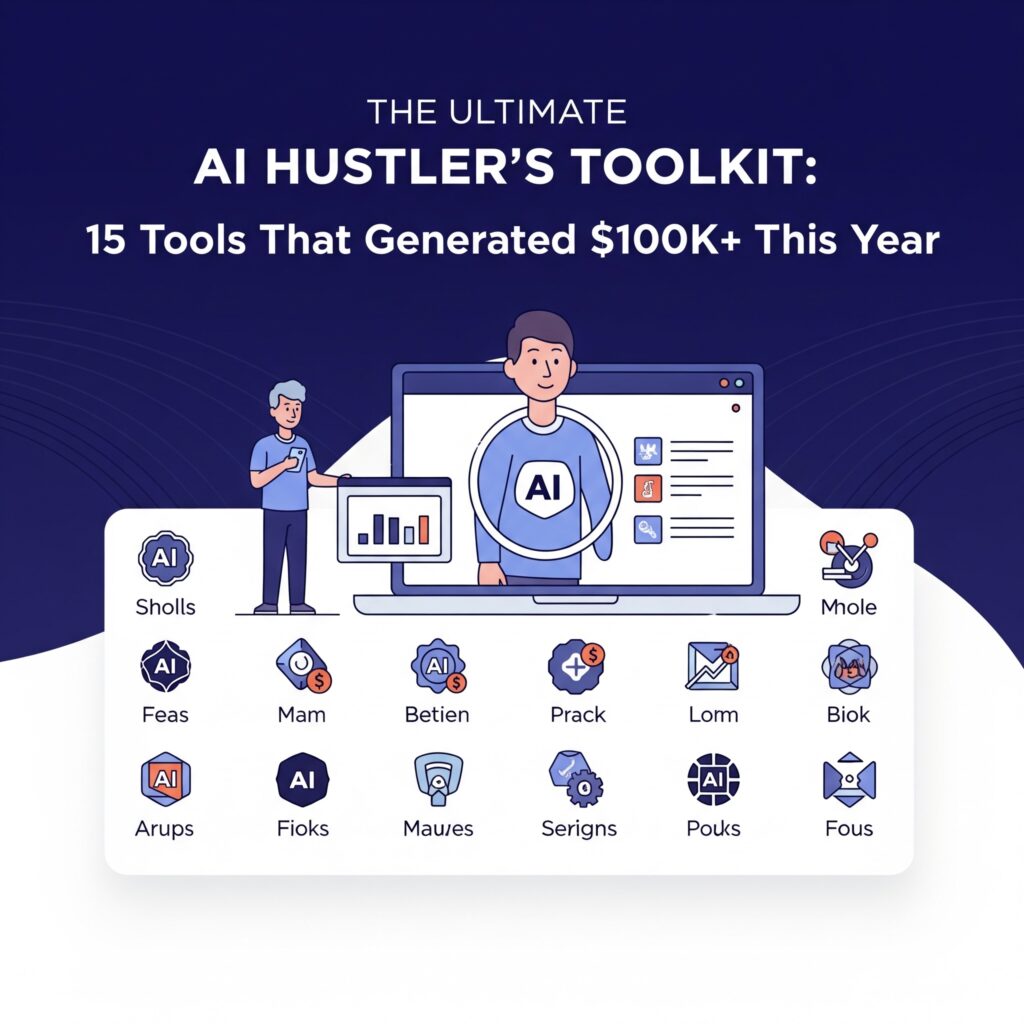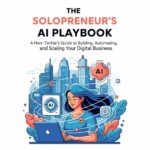
The artificial intelligence revolution isn’t just changing how we work—it’s creating entirely new opportunities for entrepreneurs to build six-figure businesses from scratch. While others debate whether AI will replace jobs, smart hustlers are already using these powerful tools to generate substantial income streams that seemed impossible just a few years ago.
In 2024 and early 2025, we’ve witnessed an unprecedented surge in AI-powered business opportunities. From content creation to customer service automation, savvy entrepreneurs have discovered how to leverage artificial intelligence to scale their operations, reduce costs, and dramatically increase their earning potential. The most successful among them aren’t just using one or two AI tools—they’re building comprehensive AI business ecosystems that work together to maximize revenue generation.
The AI Gold Rush: Why Now Is the Perfect Time
The current AI landscape presents a unique opportunity that parallels the early days of the internet. We’re in what many experts call the “AI gold rush“—a period where early adopters can establish dominant positions before markets become saturated. Unlike traditional business models that require significant capital investment, AI-powered ventures can often be launched with minimal upfront costs while delivering enterprise-level results.
The statistics speak for themselves. According to recent industry reports, businesses implementing AI tools have seen average revenue increases of 15-25% within their first year. More importantly, individual entrepreneurs using strategic AI implementations have reported income jumps ranging from $50,000 to over $500,000 annually. The key difference between those who succeed and those who don’t lies in their tool selection and implementation strategy.
Understanding the AI Business Landscape
Before diving into specific tools, it’s crucial to understand how AI business models actually generate revenue. The most successful AI hustlers aren’t just using these tools as fancy calculators or writing assistants—they’re building entire business processes around AI capabilities that solve real market problems.
The modern AI entrepreneur operates across multiple revenue streams simultaneously. They might use AI for content creation while also leveraging machine learning for market analysis, chatbots for customer service, and automation tools for lead generation. This multi-tool approach creates compound effects where each AI system enhances the performance of others, leading to exponential rather than linear growth.
Content Creation Powerhouses
ChatGPT-4 and Claude Sonnet 4 represent the foundation of most successful AI content strategies. These large language models have evolved far beyond simple text generation, becoming sophisticated business partners capable of handling complex content workflows. Successful entrepreneurs use these tools not just for writing, but for strategic planning, market research, and business development.
The real money in AI content creation comes from understanding how to prompt these systems for maximum value output. Top earners have developed proprietary prompting frameworks that consistently generate high-converting sales copy, engaging social media content, and comprehensive business strategies. They’ve learned to treat these AI systems as junior business partners rather than mere tools.
Jasper AI and Copy.ai have carved out specific niches in the content creation ecosystem. While general-purpose models excel at versatility, these specialized platforms offer refined workflows specifically designed for marketing and sales content. Entrepreneurs using these platforms report significant improvements in conversion rates, with some seeing their email open rates increase by 40% or more after implementing AI-generated subject lines and copy.
Visual Content Revolution
The visual content space has been completely transformed by AI image generators. Midjourney and DALL-E 3 have democratized professional-quality visual content creation, allowing solo entrepreneurs to produce marketing materials that previously required expensive design teams.
Successful AI hustlers have discovered that the real opportunity in AI-generated visuals isn’t just in creating pretty pictures—it’s in solving specific business problems through visual content. They’re using these tools to create product mockups, social media assets, marketing materials, and even entire brand identity systems. Some entrepreneurs have built entire agencies around AI-generated visual content, charging premium prices for rapid turnaround times that would be impossible with traditional design methods.
Canva’s AI features deserve special mention for their accessibility and integration capabilities. While not as powerful as standalone AI image generators, Canva’s AI tools excel at creating consistent, brand-aligned content at scale. Entrepreneurs using Canva’s AI features report being able to maintain robust social media presences across multiple platforms without hiring additional staff.
Video Content Automation
Video content represents one of the highest-value opportunities in the current AI landscape. Synthesia and D-ID have made professional video production accessible to anyone with a computer and internet connection. These platforms allow entrepreneurs to create spokesperson-style videos, training content, and marketing materials without cameras, studios, or professional video editing skills.
The revenue potential in AI-generated video is substantial because video content commands premium pricing in most markets. Entrepreneurs who’ve mastered these platforms are offering services that compete directly with traditional video production companies while operating with significantly lower overhead costs. Many report charging $500-2000 per video while spending less than $50 in direct costs.
Runway ML represents the cutting edge of AI video technology, offering capabilities that blur the line between artificial and professional video production. Early adopters of Runway ML are positioning themselves in emerging markets like AI-generated commercials, social media content, and even short films. The platform’s advanced features require more technical skill but offer correspondingly higher revenue potential.
Business Intelligence and Analytics
Tableau with AI integration and Microsoft Power BI have transformed how entrepreneurs understand their markets and optimize their operations. These platforms use artificial intelligence to identify patterns, predict trends, and recommend actions that directly impact revenue generation.
Successful AI hustlers use these analytics platforms not just to understand what happened in their businesses, but to predict what will happen next. They’re able to identify emerging market opportunities, optimize pricing strategies, and allocate resources more effectively than competitors using traditional analysis methods. The competitive advantage gained through AI-powered business intelligence often translates directly into increased market share and revenue growth.
Customer Service Automation
Intercom’s AI chatbots and Zendesk’s AI features have revolutionized customer service economics. Entrepreneurs using these platforms report being able to handle 10x more customer inquiries without proportionally increasing staff costs. More importantly, AI-powered customer service often provides better, more consistent experiences than human-only alternatives.
The revenue impact of AI customer service extends beyond cost savings. Better customer service leads to higher retention rates, increased customer lifetime value, and more positive reviews and referrals. Entrepreneurs who’ve implemented comprehensive AI customer service strategies report overall business growth rates 20-30% higher than before implementation.
Social Media Management at Scale
Hootsuite’s AI capabilities and Buffer’s AI assistant have made it possible for individual entrepreneurs to maintain sophisticated social media presences across multiple platforms and audiences. These tools don’t just schedule posts—they analyze audience engagement patterns, optimize posting times, and even suggest content strategies based on performance data.
The scalability offered by AI social media management is unprecedented. Solo entrepreneurs are now able to maintain social media engagement levels that previously required entire marketing teams. This capability is particularly valuable for businesses that rely on social media for lead generation and brand building.
E-commerce Optimization
Shopify’s AI features have transformed e-commerce operations, making it possible for individual entrepreneurs to compete with large retailers in terms of customer experience and operational efficiency. From inventory prediction to personalized product recommendations, AI is helping small e-commerce businesses operate with enterprise-level sophistication.
The revenue impact of AI-optimized e-commerce is measurable and significant. Entrepreneurs report conversion rate improvements of 15-25% after implementing AI-powered product recommendations and dynamic pricing strategies. Inventory optimization through AI has also reduced carrying costs while simultaneously reducing stockout rates.
Lead Generation and Sales Automation
HubSpot’s AI tools and Salesforce Einstein represent the pinnacle of AI-powered sales and marketing automation. These platforms use artificial intelligence to identify high-value prospects, optimize outreach campaigns, and predict which leads are most likely to convert.
The revenue generation potential of AI-powered sales automation is enormous because it allows entrepreneurs to scale their sales efforts without proportionally scaling their sales teams. Successful implementations report lead conversion improvements of 25-40% while simultaneously reducing the time and cost per acquisition.
Financial Management and Optimization
QuickBooks AI and Xero’s AI features have transformed financial management for small businesses and entrepreneurs. These platforms use artificial intelligence to categorize transactions, identify tax optimization opportunities, and even predict cash flow patterns.
Beyond basic bookkeeping, AI-powered financial tools help entrepreneurs make better strategic decisions by providing insights that were previously available only to businesses with dedicated financial analysis teams. This capability directly impacts profitability by identifying cost-saving opportunities and revenue optimization strategies.
Implementation Strategies for Maximum ROI
The difference between entrepreneurs who generate substantial income from AI tools and those who don’t isn’t usually the tools themselves—it’s the implementation strategy. Successful AI hustlers approach tool selection and implementation with the same rigor they’d apply to any major business investment.
Strategic tool selection involves evaluating AI platforms based on their potential revenue impact rather than their technical features. The most successful entrepreneurs choose tools that directly address their biggest business bottlenecks or opportunity areas. They also prioritize tools that integrate well with their existing systems and workflows.
Phased implementation is another key success factor. Rather than trying to implement multiple AI tools simultaneously, successful entrepreneurs roll out AI capabilities gradually, ensuring each tool is fully optimized before adding the next. This approach allows them to measure the specific impact of each tool and make adjustments before scaling up.
Building Your AI Revenue Stack
Creating a successful AI business requires more than just collecting powerful tools—it requires building an integrated AI revenue stack where different tools work together to create compound value. The most successful AI entrepreneurs have discovered how to create workflows where the output of one AI tool becomes the input for another, creating efficiency multipliers that dramatically impact their bottom line.
The foundation of any effective AI revenue stack is data integration. Tools work best when they can share information seamlessly, allowing insights from one platform to inform decisions in another. Successful entrepreneurs invest time in setting up proper data flows between their AI tools, creating unified systems that are greater than the sum of their parts.
Measuring and Optimizing AI Performance
Performance measurement is critical for maximizing the revenue potential of AI tools. Successful entrepreneurs track specific metrics for each AI implementation, including direct revenue impact, cost savings, time savings, and quality improvements. They use this data to continuously optimize their AI usage and make informed decisions about tool upgrades or replacements.
The key is establishing baseline metrics before implementing AI tools, then tracking changes over time. Many successful AI entrepreneurs report that the biggest gains come not from the initial implementation, but from the continuous optimization that follows. They treat their AI tools as investments that require ongoing management and refinement.
Future-Proofing Your AI Business Strategy
The AI landscape is evolving rapidly, with new tools and capabilities emerging regularly. Successful entrepreneurs position themselves to benefit from these developments by building adaptive AI strategies that can incorporate new tools and technologies as they become available.
This involves staying informed about AI developments, maintaining flexible tool stacks that can accommodate new platforms, and building businesses that can scale with advancing AI capabilities. The entrepreneurs who will generate the most revenue from AI over the long term are those who view AI adoption as an ongoing process rather than a one-time implementation.
Conclusion
The opportunity to build substantial income streams using AI tools has never been greater. The 15 tools outlined in this guide represent proven platforms that successful entrepreneurs are already using to generate six-figure revenues. However, tools alone don’t create success—it’s the strategic implementation, continuous optimization, and integrated approach that separates the winners from the wannabes.
The AI revolution is still in its early stages, which means there’s still time to establish dominant positions in emerging markets. The entrepreneurs who act now, implement strategically, and commit to continuous learning and optimization will be the ones who look back on this period as the foundation of their greatest business success. The tools are available, the opportunities are real, and the only question remaining is whether you’ll seize them or watch others build the AI-powered businesses you could have created.
The future belongs to those who embrace AI not as a replacement for human creativity and strategy, but as a powerful amplifier that can turn good ideas into great businesses and great businesses into industry-leading enterprises. Your AI hustler’s toolkit awaits—the only question is how you’ll use it to build your own six-figure success story.







Leave a Reply